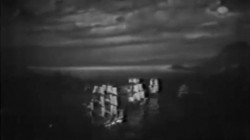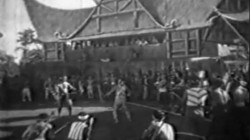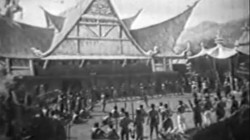If there is a name on Philipino Films that bring us over matte shots, that’s Richard Abelardo. Born in 1902, he learned scenic painting from his father, a backdrop painter for theatre. He went to California at early 20´s and started to work at Universal as scenic painting. He moved to MGM and Warner brothers. Working on films like Footlight parade (1933) or Modern times (1936)
At 1936 he went back to Philippines and introduced the glass shot and matte painting techniques to Philippines Film Industry. At the late 40`s he started to direct films, but during his director career he continued to do special effects.
I´m not sure if, during his Californian years, he executed glass or matte paintings, but he certainly learned these techniques at that time.
One of his early matte painting films was Ibong Adarna (1941) a fantasy adventure film about a magical bird, based on an epic narrative poem written in the 18th century.
The film reveals several matte painting among other special effects. Richard Abelardo was credited as art director and process shots.
His brother Bayani Abelardo was Photographic effects cameraman. Richard counted with the help of two assistants, Luzon Gamboa, and a young Ben Resella.
It is also required to make a special mention to Ben Resella. Another Philipino artist that make a huge contribution not only at his country cinema, but also in USA. Resella, nephew of Richard Abelardo, was an extraordinary painter that worked for many years as art director and matte painter at Philippines until 1966 when he moved to California were he was immediately recruited at the company J.C. Backing, specialised on scenic backdrops for film and TV.
Resella worked as scenic paint supervisor for more than 20 years painting backdrops for films like Hello Dolly (1967) Earthquake (1972) Towering inferno (1974) Star Treck (1979), Space balls (1987) and many others.
Bother in law of Richard Abelardo, Teody Carmona was art director who started his film career in 1946. He worked very often with Abelardo, and also made used of perspective tricks to enhance sets with miniatures like on the film Lapu lapu (1955)
Three images from Lapu Lapu.


